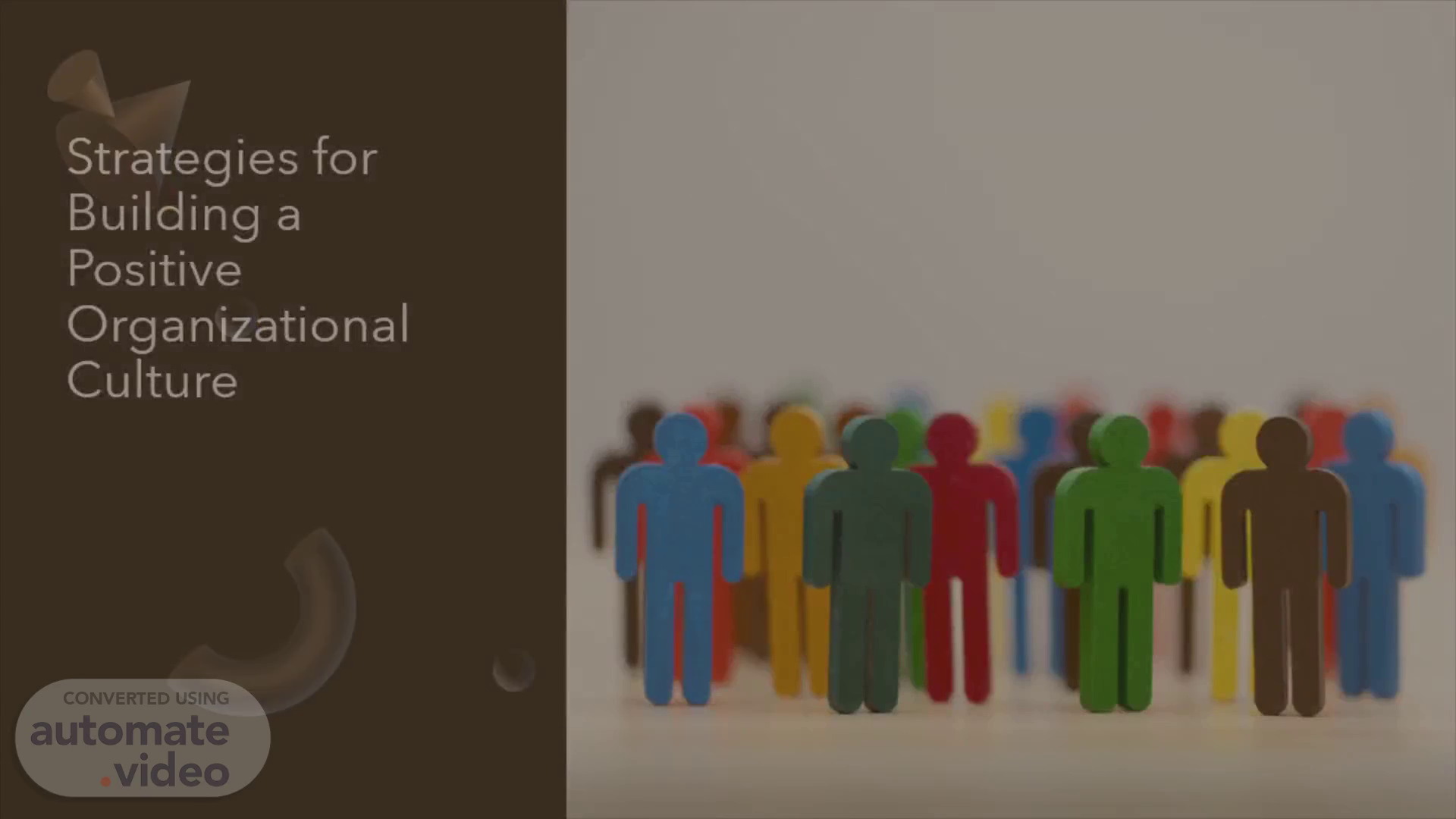
Strategies for Building a Positive Organizational Culture
Scene 1 (0s)
[Audio] Welcome to topworker. Today we will be discussing about Strategies for Building a Positive Organizational Culture..
Scene 2 (14s)
[Audio] Organizational culture is the underlying set of values, beliefs, norms, and practices that shape how individuals within a company behave and interact. It forms the backbone of an organization's identity. Importance of a Positive Organizational Culture: A positive organizational culture is more than just a nice-to-have; it's a key driver of success. It enhances employee morale, productivity, and retention, all of which contribute to better organizational outcomes. Impact on Employee Satisfaction and Performance: When employees feel aligned with their organization's culture, they are more motivated, engaged, and committed to their work. This alignment leads to higher job satisfaction and improved overall performance. Setting the Stage for the Presentation: In this presentation, we will delve into the characteristics of a positive organizational culture and explore strategies to cultivate and maintain it..
Scene 3 (1m 19s)
[Audio] Open Communication: Open communication is the foundation of a positive culture. It fosters an environment where employees feel comfortable sharing their ideas, concerns, and feedback. For example, Google holds "TGIF" meetings that encourage open dialogue with leadership. Trust and Transparency: Trust is built through transparency in decision-making, financial reporting, and communication. Patagonia, for instance, is transparent about its environmental initiatives and challenges. Collaboration and Teamwork: Promoting a culture of teamwork and collaboration encourages employees to work together towards common goals. Pixar is renowned for its collaborative approach to filmmaking. Employee Recognition: Acknowledging and rewarding employee contributions, both big and small, boosts morale and engagement. For instance, LinkedIn has its "Kudos" system for peer-to-peer recognition. Work-Life Balance: Supporting work-life balance by offering flexible schedules, remote work options, and wellness programs helps employees lead more balanced lives. Buffer is known for its remote work culture and emphasis on work-life balance..
Scene 4 (2m 46s)
[Audio] Inclusivity and Diversity: Cultivating a culture of inclusivity and diversity involves welcoming people of various backgrounds and perspectives. Salesforce is a prime example with its commitment to diversity and equality. Innovation and Learning: Encouraging innovation and continuous learning is vital. For example, Amazon fosters innovation through various initiatives, and 3M allows employees to dedicate time to personal projects via the "15% Rule." ..
Scene 5 (3m 22s)
[Audio] Leadership Buy-In and Role Modeling: Leadership should actively embody the desired culture and champion its values. A prime illustration is Apple under Steve Jobs, which emphasized innovation and creativity. Employee Engagement Programs: Creating programs that actively involve employees in decision-making and problem-solving is essential. For example, Microsoft's "Hackathon" actively engages employees in developing innovative solutions. Clear Mission and Values: Defining a clear mission statement and values that align with the desired culture is crucial. Tesla's mission to accelerate the world's transition to sustainable energy is a well-known example. Consistent Communication Channels: Establishing consistent channels for communication, such as regular town hall meetings or using communication platforms like Slack or Microsoft Teams, fosters a culture of open dialogue. Training and Development Opportunities: Investing in employee development through training, mentorship, and career growth opportunities is key. Deloitte is known for its commitment to employee development..
Scene 6 (4m 41s)
[Audio] Performance Feedback and Recognition: Implementing regular feedback and recognition systems motivates and retains employees. IBM's "You to the Power of IBM" includes performance feedback and peer recognition. Inclusive Hiring and Promotion Practices: Ensuring diversity in hiring and promotions is critical. Promoting equal opportunities and implementing diversity, equity, and inclusion (DEI) initiatives, as seen in Unilever's commitment to diverse hiring and promoting women in leadership roles..
Scene 7 (5m 19s)
[Audio] Resistance to Change: Addressing employee concerns and providing a clear vision of how the new culture will benefit them is key to overcoming resistance to change. Cultural Alignment with Business Goals: Ensuring that the culture aligns with the company's long-term business objectives is vital for maintaining its relevance and effectiveness. Managing Conflicts: Developing effective conflict resolution strategies is crucial to maintaining a harmonious culture, as it prevents issues from escalating and impacting employee morale. Sustaining Culture During Growth: Continuously reinforcing the culture as the organization expands is vital. Netflix provides an example of how to maintain a culture while scaling up by being explicit about its values and high-performance expectations..
Scene 8 (6m 13s)
[Audio] Background: Google, a multinational tech giant, is renowned for its exceptionally positive and innovative organizational culture. Strategies for Building a Positive Culture: Open Communication: Google encourages employees to express ideas through forums like "TGIF" meetings, where they can ask questions directly to leadership. Innovation: The "20% time" policy allows employees to spend 20% of their work hours on projects of their choosing, fostering creativity. Employee Perks: Google offers extensive perks, including free meals, on-site fitness centers, and flexible work hours to enhance employee well-being. Data-Driven Decision-Making: The company uses data to inform decisions and improve the work environment, like designing office spaces for collaboration. Outcomes: Google's culture has led to a high level of employee satisfaction and retention. It consistently ranks as one of the best places to work, attracting top talent in the industry..
Scene 9 (7m 27s)
[Audio] n conclusion, a positive organizational culture is the bedrock of success, and it significantly impacts employee satisfaction and performance. We encourage you to implement the strategies discussed in your own organizations and ..
Scene 10 (7m 43s)
[Audio] Thank you and open the floor for any questions and discussions you might have..